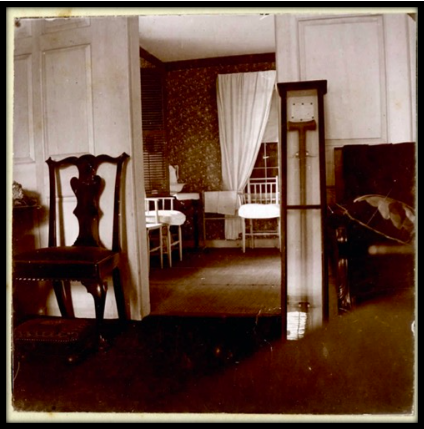The 1650 date must be approximate, as John Bowne first visited Flushing in 1651 and the family moved sometime between then and 1656. The original family cabin near the future Flushing High School, a five-minute walk from the Bowne House, would not have been built until that time. Thomas Bowne’s cabin remained standing until the 1830’s.
Another unattributed tour script from the early decades of the Museum describes the crutch as a “Staff,” and situates the bear attack “on the Turnpike, now Northern Boulevard.” The Turnpike occasionally crops up as a landmark in our 17th century Flushing land deeds, suggesting that present-day Northern Boulevard served as a major artery for the area as far back as the 1650’s. The crutch was also cataloged in record books where details of the Museum’s collection were kept in a time before computerized databases. Here we first hear of Thomas Bowne’s nickname:
Item Description: “John Bowne’s father was known as ‘Lame Thomas’ who walked with a limp and used this crutch to travel around. Family legend states that Thomas was walking through the forests of Queens when he was confronted by a black bear. His only defense was his crutch so he shoved it in the bear’s mouth and choked it to death.”
THOMAS BOWNE (1595-1677)
We know little of Thomas Bowne aside from this anecdote. He was born in “County Derby,” England in 1595 and died at Flushing in 1677 at the age of 82. His will describes him as a “Yeoman,” a freeholder or farmer who owned his own land. After his wife Mary died in 1647, Thomas lived for 30 years as a widower, which was unusual in the 17th century. Thomas emigrated from England to Boston in 1649 with his son John and daughter Dorothy. They continued to retain a share of Lime Tree Farm, the family property in their hometown of Matlock.
After a short time in Boston, the family relocated to Vlissingen (later Flushing), a settlement then part of New Netherland that had many English residents. Thomas built a cabin there and John resided with him until he married Hannah Winthrop Feake in 1656, building the Bowne House by 1661. In 1676 Thomas signed a deed of gift conferring his interest in the family farm at Matlock, England to John, from “natural affection and fatherly love,” but also “for divers other good causes and consideracions, mee thereunto especially moving.”
Thomas’s injury may have made it difficult to earn a livelihood as a farmer in the semi-wilderness of Long Island, let alone provide for a spouse; there is some documentation, including the above deed and his Will, that he relied on his son to support him in whole or part for some years. His limp notwithstanding, “Lame” Thomas Bowne evidently proved more than a match for the unlucky bear. Today, his crutch has been restored to its previous place in the Parlor, standing sentry outside what was formerly called the William Penn bedroom. His legend lives on for another generation of visitors.
HOW THE CRUTCH WAS PASSED DOWN IN THE FAMILY










